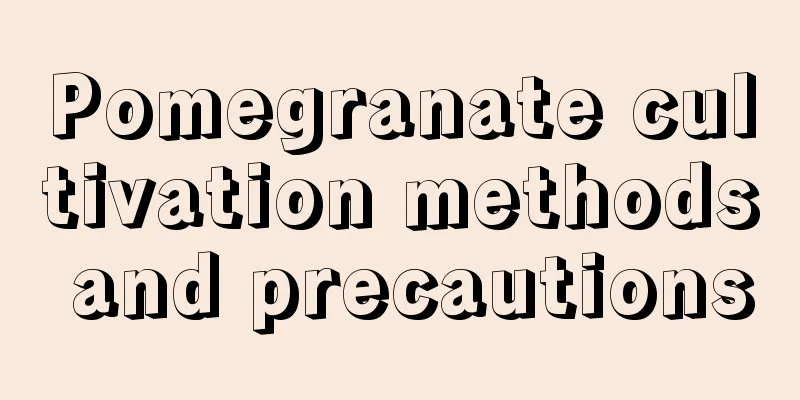Pomegranate cultivation methods and precautions

1. Maintenance methods1. Watering: When growing pomegranates in potted plants, just keep the soil slightly moist. There is no need to water them too much. Just be careful not to water the flowers during their flowering period. 2. Fertilizer: You don’t need to fertilize it too much. Apply liquid fertilizer once every half a month or so. After fertilizing, water it to allow it to fully penetrate into the soil and ensure it has enough growth needs. 3. Light: It needs sufficient light to maintain its growth. If there is insufficient light, the branches will become thin and the leaves will turn yellow. Long-term lack of light may result in the plant not blooming or bearing fruit. 4. Temperature: A growth environment of 15-25℃ is most suitable for its growth, and the ambient temperature must be up to standard during the flowering and fruiting period. If the ambient temperature is below 15℃ for a long time, it will cause the branches to grow too long, reducing the number and quality of fruits. 2. Breeding techniques1. Pruning: During the maintenance period, you should frequently prune overgrown and old branches, which is of great benefit to the overall health of the plant. It not only reduces excessive consumption of nutrients, but also increases its permeability, and insect pests will also be reduced. 2. Reproduction: There are many ways of reproduction, among which division is relatively simple. When its branches sprout in April, dig a root sucker seedling and plant it directly. 3. Problem diagnosis and treatment1. Yellow leaves: If it is caused by excessive watering, drain the water or change the soil in time. If it is caused by too much fertilizer, you need to water as soon as possible to dilute the excess fertilizer in the soil. 2. Pomegranate stem moth: This pest is very harmful to pomegranates and mainly feeds on the sap of tree branches. When this kind of pest appears, it is necessary to spray professional pesticides in time to kill the insects. IV. Other issues1. Can pomegranates be eaten? Of course pomegranates are edible. When the pomegranates are ripe, their fruits will crack. At this time, you can pick them, peel them and eat them. 2. Can it be grown indoors: Pomegranates can be grown indoors, provided that there is good lighting indoors, because pomegranate trees need sufficient light to grow and they also need frequent ventilation. |
<<: Christmas Rose Cultivation Methods and Precautions
>>: Cultivation methods and precautions of Shilongrui
Recommend
How to grow chestnut tree seedlings
1. Breeding methods 1. Seeds: The seeds of this t...
How to grow miniature coconut palm in autumn
1. Increase sunlight It is not tolerant to strong...
What to do if Mimosa doesn't bloom
Why doesn't mimosa bloom? When growing mimosa...
How to grow potted aloe vera? Cultivation methods and precautions
Aloe vera pot cultivation method 1. Temperature: ...
What can be planted in rural areas to make money without worrying about sales? What is the most profitable and stable plant currently?
What to plant in rural areas to make money Nowada...
Cultivation methods and precautions of Endless Summer Hydrangea
1. Sunlight Endless Summer Hydrangea loves sunlig...
Nutritional value and efficacy of lettuce
1. Lowers blood pressure Lettuce is a high-potass...
Digitalis pictures
Digitalis pictures Beauty is always connected. Lo...
How to breed Phoenix succulent and what to pay attention to
Phoenix succulent breeding method There are three...
How to propagate new bulbs of tulips (how to cultivate and plant bulbs of tulips)
Tulips are relatively precious flowers abroad. Th...
Can the leaves of the golden diamond be transplanted to survive?
1. Can it be inserted alive? The leaves of the go...
Can you raise fish by hydroponically growing pennywort? What hydroponic plants can you use to raise fish?
1. Is it possible to raise fish? You can raise fi...
Can Clivia be placed on the balcony? Can it be exposed to the sun?
1. Can it be placed on the balcony? It is a semi-...
Chrysanthemum repotting time and method
Chrysanthemum repotting time It is recommended to...
How to grow lucky bamboo to make it grow well and where to put it in the home
1. How to raise it to grow well 1. Soil culture: ...









